• AN EXHAUSTIVE STUDY: Here I present Part I of a series of a comprehensive sub-genre analysis features that began back in 2015 (Technical Thrash Metal, Melodic Hardcore/Skatepunk) on another site. This second pass for Melodic Black Metal will be a more comprehensive redux of the series which began back in 2017 and generally completed in 2018 wherein seven enormous entries detailed key releases from 1991-2005. It is necessary to rewrite, ‘remaster’ and approach this subject another time due to the old columns no longer linking to their album artwork, most of them weren’t very thoughtfully written, and the type of posts used were not created for mobile readership rendering them impossible to read. This will not be a plain recreation of that list but rather a more complete, far more in-depth format which makes less of an effort to draw the line between sub-genres and instead aims to better understand the delineation between melodic black metal and the general evolutionary origin of the sub-genre next to many others.
The method for this type of feature is simple: I procure a chronological list of demos, EPs, splits and full-lengths from various sources. I then re-listen to every release in order, research each band, and report my thoughts and observations including trivia and relevance. This time around I will include ~6-10 items per entry and each one will (eventually) include a short video. Instead of deciding if these releases truly resemble the sub-genre suggested per available public databases (Metal Archives, Discogs, Rateyourmusic, etc.) I will further make the argument for what releases I believe are in keeping with the canonical highest standard, influential or important items for the melodic black metal form. This should allow some understanding of this musical style and the need for distinction between subculture movements in underground music and the incessant waves of imitation beyond the original thought. — This first entry will consider the sub-genre in its most naive and unformed state and will call for at least some general narration of the various black metal scenes, styles, and trains of thought which lead to certain bands being labeled “melodic” then and in hindsight. Level headed, respectful feedback is welcomed by way of grizzlybutts@hotmail.com
MCMXC – Deformation
There were a small number of important bands active and/or in their formative stages circa 1990 CE which’d eventually contributed to melodic black metal in significant ways alongside a number of groups that’d influenced the melodic black/death metal hybridization out of certain parts of Sweden. They’d been death metal bands in a certain majority which’d easily made the transition to black metal, some were considered early second wave black metal groups in a primordial state, others ultimately fit in the melodic black metal category once they’d learned to play their instruments. The influence of Slayer, King Diamond, Morbid Angel, and (in some cases) Samael cannot be understated and likewise we will see a lot of Scandinavian teenagers wearing Incubus ‘God Died on His Knees‘ t-shirts when looking through old photos from 1989-1990. There are three purposeful omissions which we should not yet include in our examination:
First is of course [1] Necrophobic‘s first two demos, their 7″ single, and EP as these represent the evolution of a thrash metal band unto one of the best death metal groups (and releases) of the early 90’s. The pre-1992 history of the band isn’t exactly as important to the discussion as ‘The Nocturnal Silence‘ will be in terms of style notes, guitar arrangements, aesthetic and lyricism. The major note to take there is that the delineation of style wasn’t yet concrete when those songs were written, at least not as rigid as folks have set it in hindsight. The early history of groups like [2] Rotting Christ and Varathron might also be up for discussion but by 1990 their thrash metal roots were still most prominent, though we would find later versions of some of those pieces changed to more of a black metal style. It would be fair to argue for the inclusion of those formative releases though they were melodic in the sense that Kreator was in the late 80’s. I’d similarly hesitate to detail the history of [3] The Black Flame (Sweden) for their ‘stepping stone’ status as Jon Nödtveidt expanded his repertoire beyond death and thrash metal in said group (eventually known as The Black) but it would serve more as adjacent trivia, such as the inclusion of Rabbit’s Carrot.
If we went down that rabbit hole, so to speak, we’d just as well pull from Morbid‘s ‘December Moon‘, Sorcery‘s ‘The Arrival‘ and countless other obscurities for the sort of tapes that’d taken ideas from heavy and thrash metal and given them an evil ‘black metal’ pace and attack, as we begin considering the drastic steps it’d taken to see the horizon beyond Bathory (and eh, Venom) of a certain era. If you have this 80’s “evil heavy metal” context readily available in mind you will better understand the major criteria for the feeling, aesthetic and canonical experience of melodic black metal; Of course we could just as well argue against the inclusion of the first four demo tapes mentioned on this list and stride right into the more concrete ideas found circa 1991 but I’d found the contrast of what a difference a year makes illuminating, or, at least interesting in documenting the unprecedented sea-change and sophistication which occurs in the earliest 90’s.
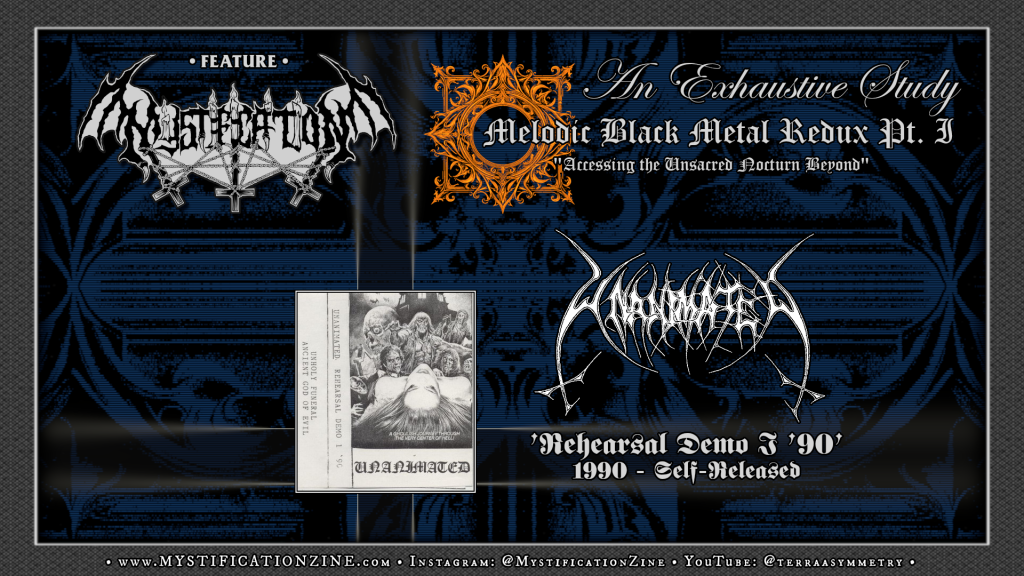
By most believably stated reports, the camaraderie of the early Swedish death metal scene was a huge reason for its success. There were ‘try-hards’ and folks who did not fit in, of course, but by most accounts things were supportive and often collaborative in their shared inspiration for heavy music. The attitude was right and the music was as well. This’d brought many folks into the fray with a fairly standard introduction such as this two song rehearsal tape from Stockholm-borne trio Unanimated, a frayed and ruddy set of short pieces where the enthusiasm of Dismember‘s early work is often cited as their initial inspiration. Of course we must credit Unanimated with much more than this, their own style would arrive in 1991, but in terms of Swedish death metal circa 1990 they were rabid and intent on chaotic speed as they grind through these simple two-tiered riffs which may as well be Repulsion covers. This was the era of incredible bands like Grotesque and Merciless, so, from the perspective of a death metal fan this tape is a primitive relic of participation more than anything else but a vital starting place for an important act. The key takeaway here with this first entry is that the Swedish death metal scene adapted to the innovations of their peers and this did not reach a level of opportunistic plagiarism and “competition” as fast as many have commented over the years. The death metal underground to melodic black/death austerity of the mid-90’s is exemplified in this band’s work.
More Info:
YouTube: https://www.youtube.com/watch?v=ao6O63Tl6JY
Discogs: https://www.discogs.com/release/2239685-Unanimated-Rehearsal-Demo-1-90
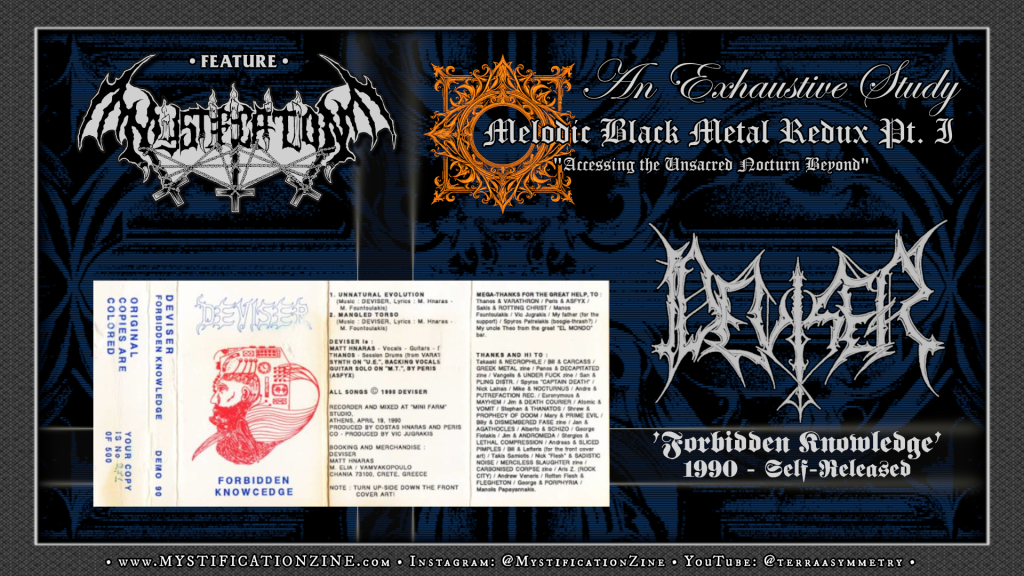
There are many relics of the Greek black, death and extreme thrash scenery of the late 80’s which bring together similar a storms of interest which do well to showcase what a few very enthusiastic, driven fans of underground music can put together unhindered by anything but their own creativity. Well, of course I don’t mean to suggest that Crete-borne project Deviser‘s (by way of Matt Hnaras) first tape sports a legendary set of songs, the band would admit the early material is specific to the inspiration of each member and not intending any one style, but that a few moments studying its contents and the insert for the tape reveals tons of avenues for the old school, the weird, and the now legendary. To start this recording features early Varathron drummer Thanos Mitropoulos who went on to play bass for cult death metal band Septicemia and Horrified (Grc). Likewise Periklis Tsoukalas plays on this tape, and you can see a bit of love for Voivod on this recording’s illustration but also in his own band Asfyx who’d put out one of the earliest and most unusual Greek black metal recordings (‘The Spirit of the Dead‘, even has a cover of “Voivod”). We find some hardcore punk muscle memory in the drums, some of the thrashing dramatism of early Varathron tapes, and a general strange tarantella of speed metallic riffcraft conjuring an ominous and quirk-ridden form here. The best part of exploring these nascent years of Deviser is that each tape would change their sound quite a bit since Hnaras always seems to have built the band around collaboration rather than assignment. In this sense we will find something entirely different on their next tape (‘Psychic Completion‘, Oct. 1990) but the side of the band most relevant to melodic black metal arguably arrives around 1993.
Liner notes include folks from most of the best known Greek zines of old, Stephan from Thanatos, Sakis from Rotting Christ, various Florida death metal elite, UK and Greek metalpunk bands (Prophecy of Doom, Death Courier) and even Euronymous. When I look at long thank you lists and the amount of creative enthusiasm going into an early work like this it is a reminder that sub-genre elitism and “specialists” were not as important to the sustenance of true underground metal as people seem to think, not until folks (eh, like Deathlike Silence) began to incite a culture of competition as the primary source of black metal. Feel free to disagree and offer your perspective if you were active in tape trading in the late 80’s / early 90’s.
More Info:
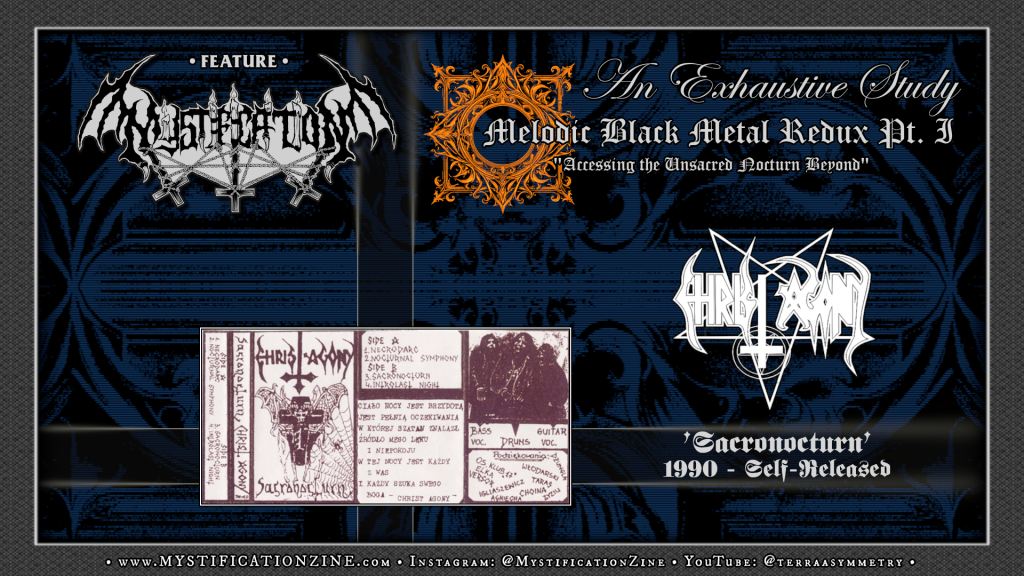
Northern Poland (Morąg) borne trio Christ Agony are rightful legends of the ‘old school’ black metal underground, led by Cezary A. and starting with this substantial ~27 minute, four song tape they’d developed a reputation for punishing yet ominous, often doomed yet melodic style which’d developed more clearly by 1993. Assuredly inspired by Venom, Hellhammer and early Celtic Frost for opener “Necrodark” and equally imposing puncher “Nocturnal Symphony” we begin to see shades of Bathory and classic heavy metal as we reach the second half of this tape which presents the rumbling romanticism of the title track (“Sacronocturn”) with its seemingly lost basslines and performative vaunting as if to showcase that these folks rehearsed and jammed quite a bit to develop these lengthy 6-7 minute pieces. I would classify this as a formative relic, a classic moment for Polish black metal as a whole which offers small glimpses into the doomed and dramatic Satanic black metal that would eventually arrive. The musicianship is rough to the point that we are merely getting a raw outline of things to come. Fans of early Samael (through ~1993) will especially appreciate this approach and how it develops over the next 2-3 releases. In terms of melodic black metal there are chord shapes and introspective, ominous enough moments that we can begin to see it coming but I don’t think we get signature Christ Agony until they’d discovered Dissection‘s post-1991 work.
More Info:
YouTube: https://www.youtube.com/watch?v=14oLwO1s3OI
Witching Hour: https://witchinghourproductions.bandcamp.com/album/sacronocturn
MCMXCI – Advent Horizon
As we breach the slow wave of blackened death metal arisen across the globe circa 1991 CE we find a realm where pronounced melodicism and dark, ominous and dramatic atmosphere begins to insert itself into distinctive traits. There are plenty of opportunities to argue about what constitutes use of melody and which type of effort deserves the additional tag, for example ‘Nema‘ from Enslaved (Norway) certainly had its moments, but it will make crystal clear sense for those who’ve closely studied all of the black and death metal variants from 1991 (it is a finite quantity of releases, you’re a lazy wimp) in both demo and full-length formats. That is to say that for years the grey area shared between black and death metal was beginning to insist upon separate definitions with clarified traits. Death metal most often held some inherent “rock” melody to it, even at its most hardcore punk thrashing state, but the most puritanical black metal soldiers tending to post-teenaged cultural sophistry during the emergence of the “second wave” began to insist that their own superior form of anti-music should by default be amelodic. We don’t need to dig any deeper than this fabled Scandinavian zeitgeisting beyond recognizing the distinction between what was considered melodic for its time versus traits of technical, brutal and doomed aptitudes. These distinctions did not become important to make beyond the marketing tactics of larger entities as both death metal and black metal became momentarily relevant commodities for tentative onlookers. The best place to start drawing the line and identifying the craft comes with the Swedish death metal scene and its close relationship with black metal, either as extant Bathory enjoyers (Merciless) or folks recognizing the merits of the scant few bands I’ll include here for 1991.
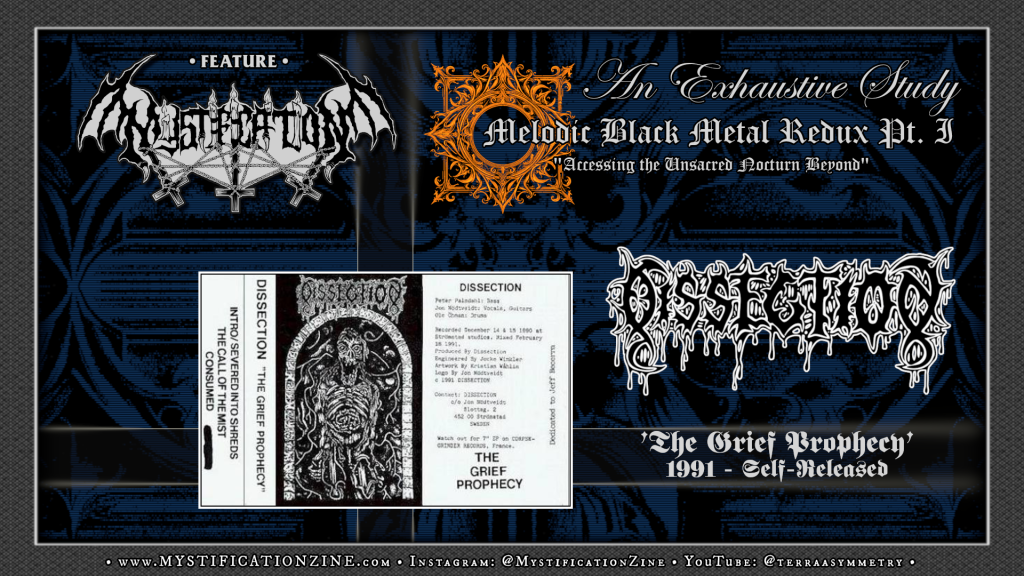
A then fourteen year-old Jon Nödtveidt would leave his kind of goofy thrash metal group Rabbit’s Carrot in early 1990 and form Dissection, an above-average death metal band, with bassist Peter Palmdahl and drummer Ole Öhman and since they were kids… and perhaps fairly privileged folks based on descriptions of their lives, their first official demo tape would face several delays until February of 1991. Nödtveidt had attended a school specifically attuned to his interest in music as far as I understand and one could already hear some refined transitional ideas and unique rhythmic lines in his work but most of ‘Thy Grief Prophecy‘ wasn’t so far removed from the standards set by early Grave and such but that first tape had style, the right look, and its material was more sophisticated than much of what’d been released in 1990. In terms of this mood and style the exception is probably Sentenced‘s ‘When Death Joins Us‘ tape from 1990 and ‘Hallucinating Anxiety‘ from Cadaver remains underrated but when we look at Swedish death metal this was a release which had a lot of push behind it and built up contacts which were crucial for things to come. That said, we cannot consider the first Dissection tape more than a formative step taken with its pitch shifted vocals and such and there were not yet any hints of developing melodicism or black metal focus just yet. A tape like ‘Fuck Me Jesus‘ from Marduk was much more advanced in terms of death metal musicianship and black metal songcraft by comparison. The band will have their day under the black sun soon enough but for now there were other bands that’d contributed to the subject at hand far more during the eight months it took for ‘Into Infinite Obscurity‘ to cook up. Again, the early stuff will provide a strong point of contrast soon enough.
More Info:
YouTube:
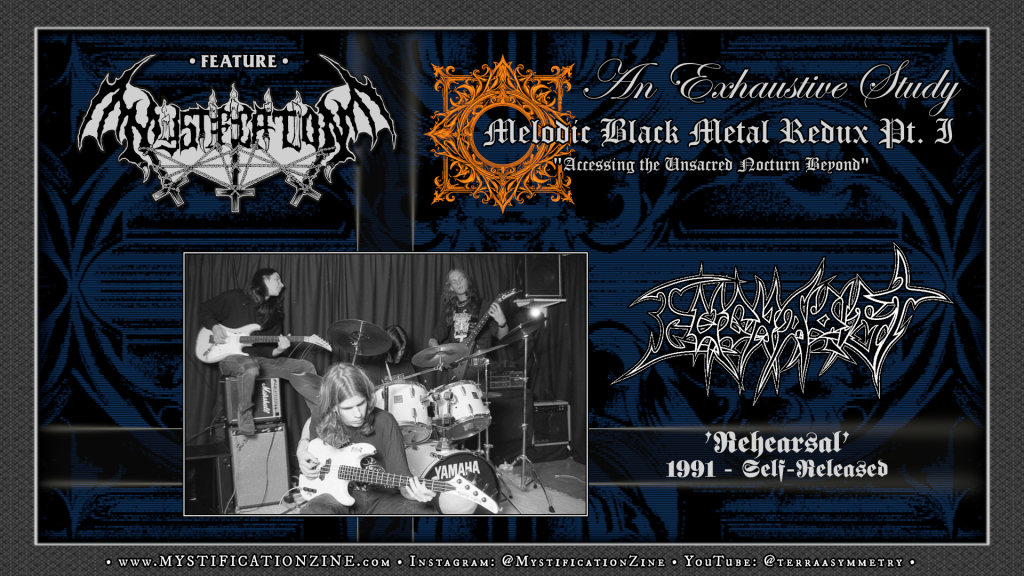
With many retrospective interviews, books and thorough ‘old school’ death metal documentation available today we find that Veddige-borne quartet Eucharist‘s work leading up to and including their first full-length album was highly influential to Sweden’s melodic death and black metal development. From what I’ve heard they were not especially ready with their sound on rehearsal tracks from 1989 but by 1991 they had these pieces mostly set and structured in a way which serves as the core template for the Swedish melodic black/death metal equation. Ripping and precise pacing, twisted-out romanticist riffs, and a unique sense of composition give us the mechanics for unique dual guitar harmonization, contrapuntal rhythmic lines, and phrases seemingly pulled directly from both classical music and the pure death metal experience. Distant rasping vocals on these recordings help this rehearsal sound somewhat akin to Dawn‘s debut LP (ca. 1994) to some degree. Though the spirit of what we are after in terms of musicianship and composition has finally arrived in glowing example lets not get entirely too far ahead of ourselves as the remainder of 1991 and 1992 flesh these ideas out even further before any of these bands were “LP ready”.
Note: Uncredited rehearsal photo from 1991 taken from Eucharist‘s twitter, without permission.
More Info:
YouTube: https://www.youtube.com/watch?app=desktop&v=TgUU1T1-Pd8
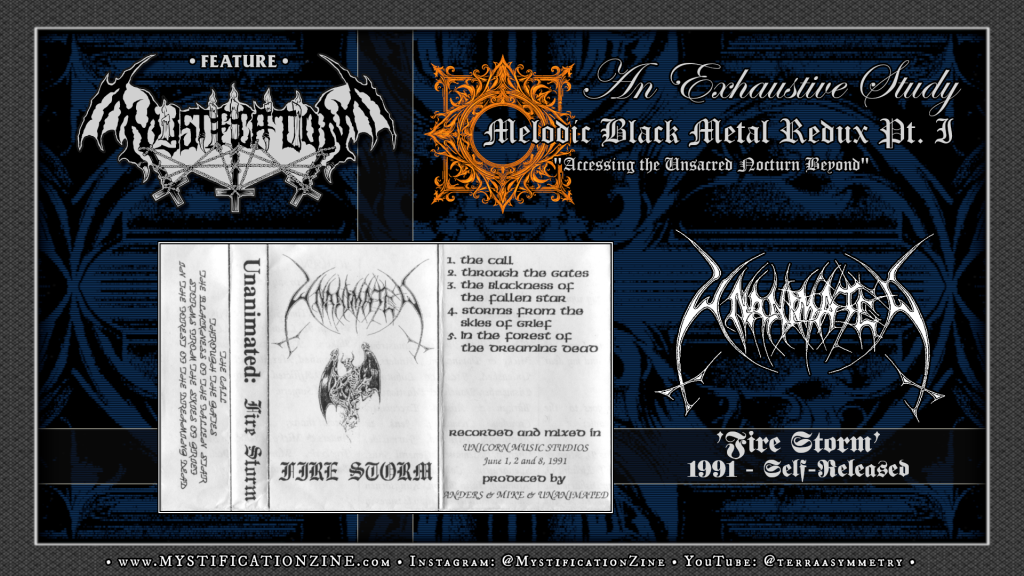
Open the gates! From my point of view this is the first masterpiece of a demo afforded our exploration of melodic black metal, the right attack and spirited dramatism applied to these high-functioning heavy metal pieces delivered by a truly blackened death metal band. The keyboards which guide us “Through the Gates” had the upper hand on most anything released in this style, escaping to-direct Nocturnus and early Morbid Angel-isms while retaining the wrathful attack of Grotesque (Sweden) throughout. Over the years the tendency has been to compare most of what’d released in 1991 adjacent to this style directly to ‘Gardens of Grief‘ but since we’ve just taken careful listen to Eucharist‘s rehearsal tape from the same year it was clear there were very different currents brewing long before (the otherwise adjacent and important) At the Gates comes into this conversation. Where we can most clearly draw the line is the Bathory inspired “Storms from the Skies of Grief” which nearly begins to sound like an early Katatonia piece as it develops. I’ve long been a huge fan of this band and this demo in particular because it captures both the essence of elite Swedish death metal (the stuff with riffs, eh) and proves how sophisticate that work can be sidled next to ominous keys, blasts, and wrathfully thrashing elements of black metal. We can definitely question the decisions they made on their debut in the future but this tape should be enough to characterize the sense it’d made to link death metal and black metal of the time with a bit of Quorthon-ian fire to help create the right tone.
More Info:
YouTube: https://www.youtube.com/watch?v=xAUG4g0ngWk&list=OLAK5uy_nr4fUTydnGW8p16IXRlYgo_tycuP23P9c&index=13
‘Fire Storm‘ has been remastered and included in the 2LP remaster of ‘In the Forest of the Dreaming Dead‘ via Century Media. This is absolutely essential archive worthy stuff even if you don’t care for remasters.
Comments circa 2017: “Nocturnus–influenced melodic death metal that serves as a proto-melodic black metal example if you’ll pay attention to the band’s sound, riff delivery, use of keyboards. This feels very much like an early example of melodic death metal with black metal elements. If you don’t feel like Dissection totally ripped off this band, this might change your mind putting them side by side. I’d venture a guess that they simply evolved together rather than in opposition to each other. Both bands were still very much death metal groups at the time, but I’d argue that Unanimated ‘created’ this style on this demo, feel free to say I’m wrong I very well could be totally off the mark. “The Blackness of a Fallen Star” sure feels like The Somberlain, though.”
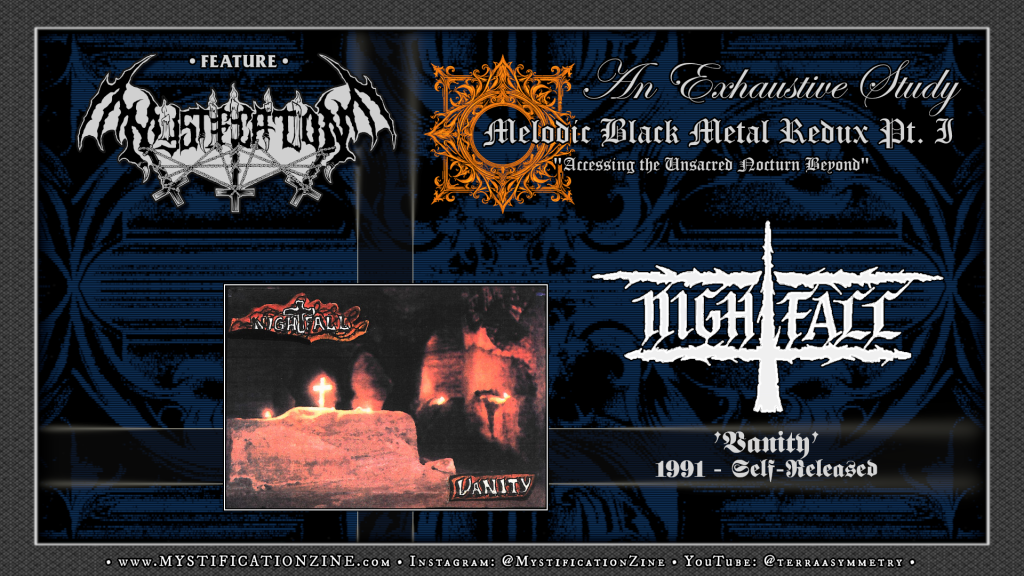
The history of Nightfall is somewhat interesting in the sense that their beginnings came after vocalist and bassist Efthimis Karadimas left thrash metal band Epidemic after the rest of the band (allegedly) jumped him and robbed him after a gig. The band didn’t have a great reputation by some reports, something about lying about attendance at a London gig, but the important thing was that Karadimas left angry and as he explains in the extensive liner notes for the vinyl and CD reissues for this very professional and atmospheric demo recording the focus of this band (and tape) was to do something bigger and in furious reaction to the times. There are elements of thrash, death metal, heavy use of keyboards, shredding solos, gothic lyrics, and somehow this all manages to be the right sort of unbalanced bridge between thrash and Hellenic black metal sounds. This is probably one of the more death-thrash adjacent releases from this particular canon but fans of Greek black metal style and atmosphere will find it here and thanks to exceptional bass guitar playing and (again) a very strong production value for a demo from 1991 this is a notable release for its time. Of course the early discography of this band is inconsistent and in some respects they’d done a better job of it on ‘Parade Into Centuries‘ (1992) where most of these pieces are recreated. Nonetheless, the starting point for this melodic black/death outlier from the Athens scene provides important foreshadowing for their first three or so recordings and while they never provided typical melodic black metal traits it adds to the greater scene of experimentation and innovation per the times depicted.
Trivia: The early days of this band also featured another link to death metal band Septicemia per their drummer, and one of the key guitarists for Nightfall‘s 90’s releases also started a short lived melodic death band with Bill Z. (Soulskinner) named Vanity in 1993.
More Info:
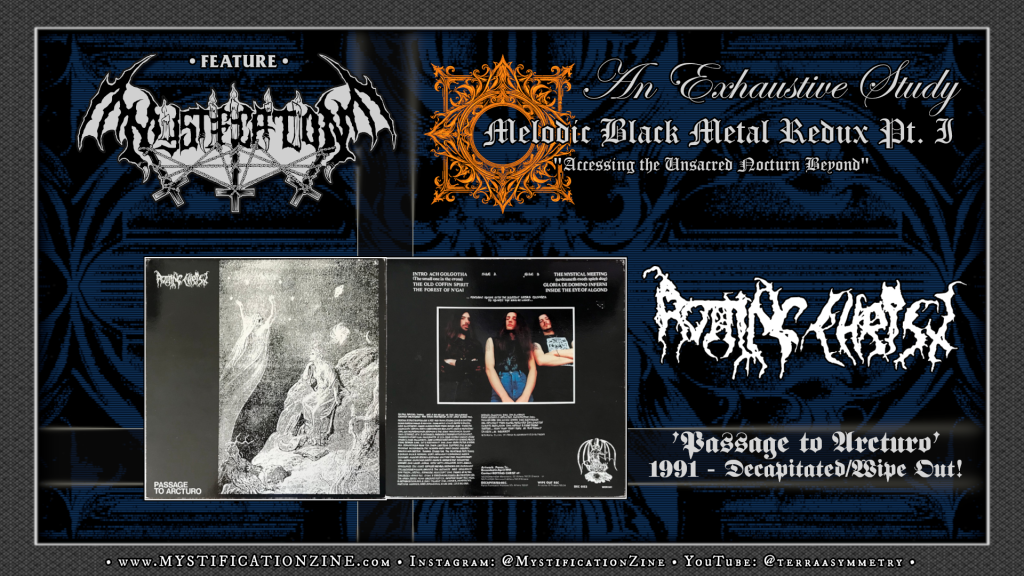
One of my all-time favorite releases in black metal and a second formative statement of intent from Rotting Christ, it’d taken about a year for the band to decide to play black metal on their third demo (‘Satanas Tedeum‘, 1989) but it was on their first 12″ mLP ‘Passage to Arcturo‘ where the quartet began to reach beyond their dark thrash mindset and generate memorable riffs and unique atmosphere, pieces which I’ve always found stood out in mind. “The Forest of N’gai” specifically showcases the odd sense of movement, the sped up Venom beats and the buzzing guitars with interjections from keys/chorales which’d caught me off guard many years ago as a death metal demo diver looking for something blasphemous. Of course we will find the pacing and style here rhythmically related to Varathron‘s similarly developed ‘One Step Beyond Dreams‘, per the shared drummer and whatnot but the hazy, scratched at atmosphere of this recording is unique. Anyhow, the important thing is that this was the first hint of viably melodic language developing by way of Sakis Tolis‘ guitar arrangements but we are not fully there yet beyond a compelling personae having arisen on this recording.
More Info:
Trivia: If you recall the notes from the first Deviser tape thanked Panos from Decapitated Zine which was also the same fellow who released this record under Decapitated Records, a precursor to Unisound Records.
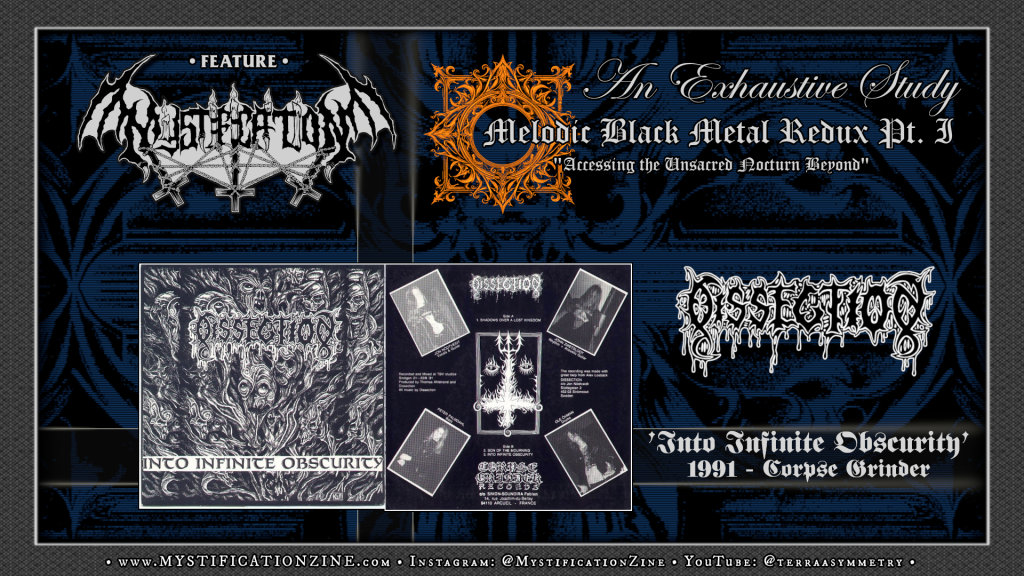
The most important conversation to have about ‘Into Infinite Obscurity‘ is probably its role in the collective creation and standard borne for early melodic death metal as we find a studiously rehearsed, tightly performed, and rigorously composed elevation beyond anything found on ‘The Grief Prophecy‘ (1991) per this follow-up 7″. Dissection provides us their first astonishing leap into view, their breakthrough material, which is still one of the most exciting developments in the early 90’s for my own taste. This would be the standard set and we could see At the Gates developing similarly taut, artful and melodic ideas early on but Nödtveidt‘s insane vocals are the revelation beyond the insertion of ripping blasts (“Son of the Mourning”) and the introduction of a new standard for melodic lead-driven songcraft (“Shadows Over a Lost Kingdom”). As a death metal fan idolizing the first Atheist album and picking through records like ‘Spiritually Uncontrolled Art‘ seeking riffs in hindsight, the discovery of this record was my gateway to melodic death and black metal in general and a squarely convincing article. I won’t suggest that Unanimated and Eucharist didn’t simultaneously deliver pieces of this vision first, but here it seems these folks were determined to strike harder than before, driven to make these two songs count not only in terms of their craft but the expression available to them. The true fan of heavy music cannot possibly ignore the quality of these pieces and should endeavor to understand the door they’d ripped open.
More Info:
YouTube:https://www.youtube.com/watch?v=Dx26diUD6H0&list=OLAK5uy_kHjKo43ijn2x8HC-A4iSbcy5u97HCPdd0
Remarks circa 2017: “While the earlier Dissection demo and rehearsal were fine Autopsy worship it wasn’t until this EP that the band changed the vocal inflection and general shift from death metal towards melodic death/black metal. Dissection were clearly the originators of this style to some degree, though I think At the Gates really were the inception, it just so happens that their material ‘felt’ more like black metal and their on stage appearance would change in turn. I’ve included a link to Dissections first demo so you can compare and see the huge leap in both quality and style. If you really want me to be honest as to how I feel I believe At the Gates essentially opened up the melodic possibilities of death metal and in turn inspired Dissection to likewise expand their horizons. Some say this happened concurrently and collaboratively by some accounts, I’m not entirely sure.“
Between 1990 and 1991 artists like Dissection were paving a different path and putting in serious work to realize a much bigger vision but thus far we’ve only seen and heard slivers of the real thing. Granted, plenty more records were brewing from 1991 through 1993, wherein a number of artists eventually provided their own substantial breakthroughs across the board. Part II of this series will take a closer look at 1992, with roughly twelve releases (again, primarily demos) as we carve our way towards recordings which are functionally melodic black/death metal of differing design. The closing point to be made here is the argument that part of what made the initial influx of melodic black metal acts so inspired was an education in not only nascent black metal and heavy metal but a practiced hand in the ways of peak North American and European death metal riffcraft.

Help Support Grizzly Butts’ goals with a donation:
Please consider donating directly to site costs and project funding using PayPal.
$1.00
Make a one-time donation
Make a monthly donation
Make a yearly donation
Choose an amount
Or enter a custom amount
Your contribution is appreciated.
Your contribution is appreciated.
Your contribution is appreciated.
DonateDonate monthlyDonate yearly
